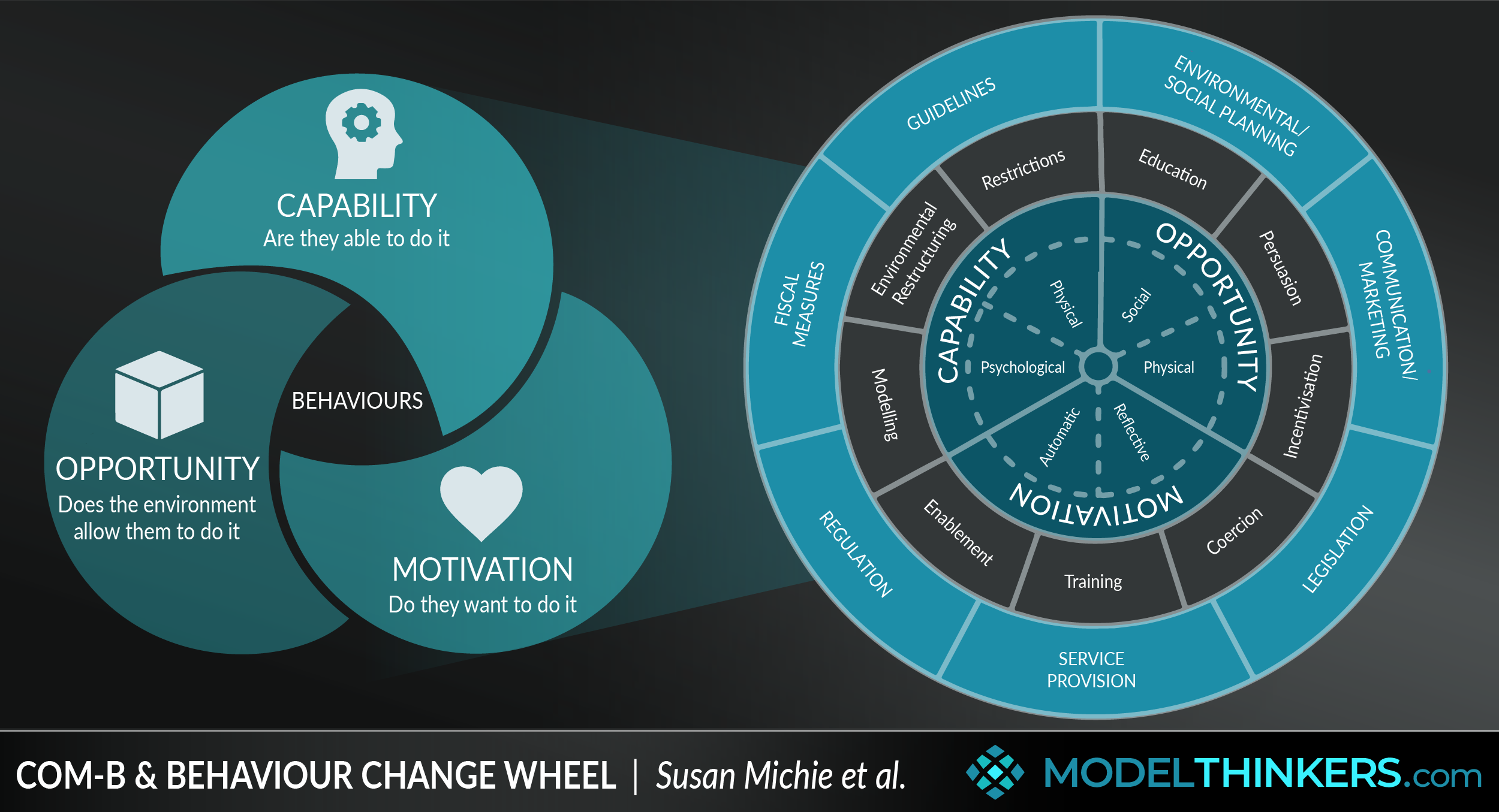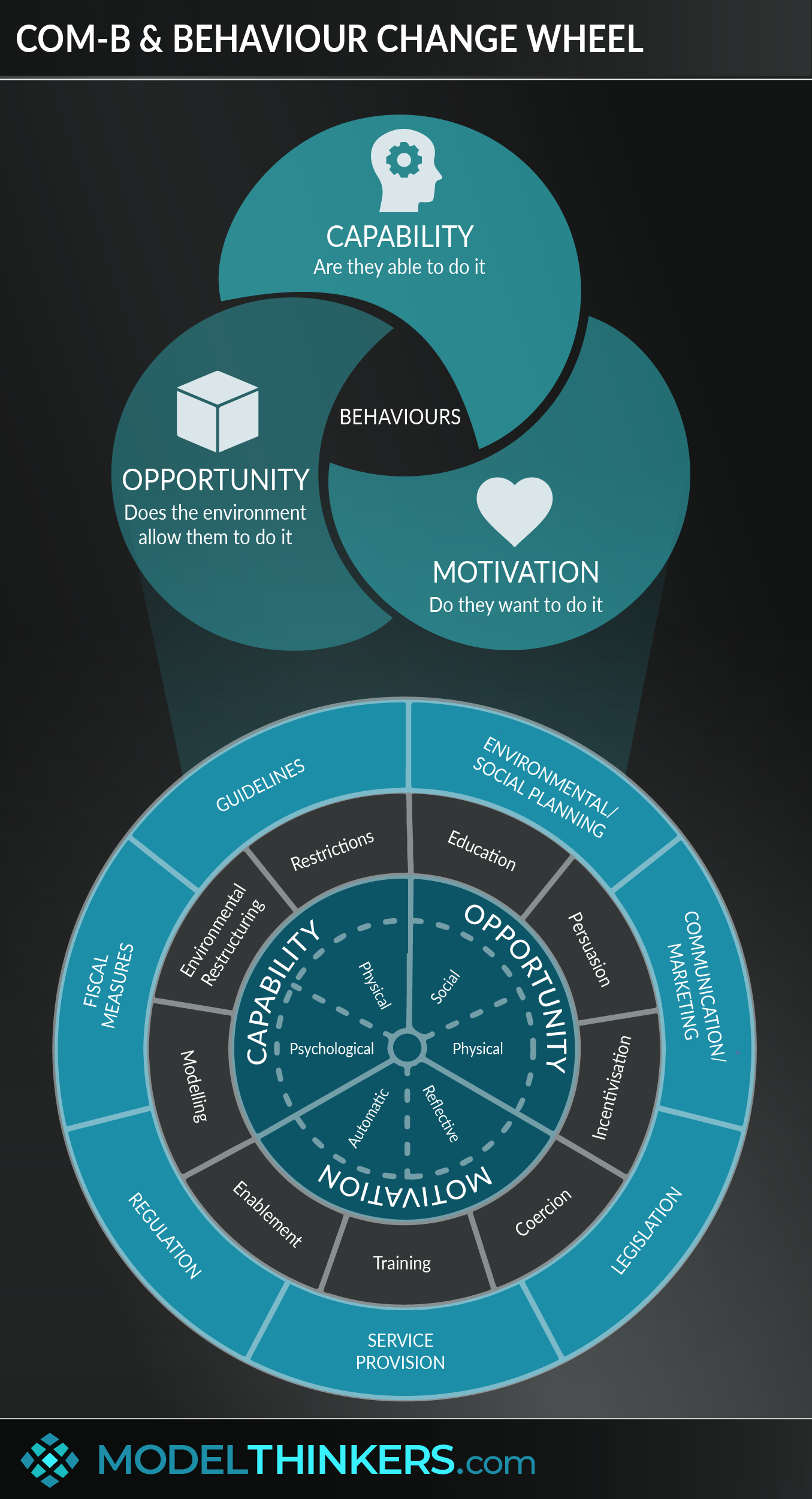

 0 saved
0 saved
 83.9K views
83.9K views








Whether you’re shaping the culture of a team, shifting customer behaviour as part of a product launch, or wanting to change and improve yourself, you’ll need to understand the art and science of behavioural change. The Behaviour Change Wheel is a great place to start that journey because it distils impactful behavioural strategies from 19 existing models into a single framework.
The Behaviour Change Wheel (BCW) is a framework for describing, designing and evaluating behaviour change strategies. At its heart is the COM-B behaviour model, which posits that Behaviour occurs as an interaction between Capability, Opportunity, and Motivation.
USING COM-B.
COM-B forms the centre of the Behavioural Change Wheel and consists of three key elements that influence behaviour. COM-B might be enough for your needs, but if you want to go deeper you can explore two sub-elements for Capability, Opportunity and Motivation. Still want more? Then you can go further with the Theoretical Domain Framework (TDF) which cites 14 categories of behavioural elements. The COM-B sub-elements and TDF are mapped against COM-B below:
| ____ |
SUB- ELEMENTS |
TDF |
QUESTIONS TO EXPLORE RELEVANCE |
|
C A P A B I L I T Y |
Physical - skills and knowledge such as operating equipment or tools. |
|
Do they have the ability to adopt the target behaviours:
|
|
Psychological - skills and knowledge such as decision-making. |
|
||
|
O P P O R T U N I T Y |
Physical - the environment, time and resources. E.g. giving up smoking by going to a place where smoking is not allowed. |
|
Do they have the opportunity to adopt the target behaviours:
|
|
Social - behaviour and expectations of peers and networks including cultural norms. E.g. giving up smoking with a support group of non-smokers. |
|
||
|
M O T I V A T I O N |
Reflective - thought processes such as plans, beliefs and intentions. E.g. planning to stop smoking because of the health benefits. |
|
Are they motivated to adopt the target behaviours:
|
|
Automatic - more intrinsic such as emotional responses, desires, and impulses. E.g. physical response to the thought of smoking. |
|
INTERVENTIONS AND POLICIES.
The middle circle on the wheel after COM-B captures types of interventions that can support the required behaviour change. The outer wheel represents policy classifications that such interventions might fall under.
The policy categories are environmental and social planning; communication and marketing; legislation; service proposition; regulation; fiscal measures; and guidelines. Perhaps a more practical lens, however, are the interventions which we’ve broken down further below:
|
INTERVENTION |
DEFINITION |
LINK TO COM-B & SUB ELEMENTS |
|
Education |
Informing and explaining to increase knowledge and understanding. |
Capability - psychological. Motivation - reflective. |
|
Persuasion |
Influencing to develop positive or negative feelings that stimulate action. |
Motivation - reflective or automatic |
|
Incentivisation |
Establishing rewards and incentives. |
Motivation - reflective or automatic |
|
Coercion |
Establishing punishments and costs. |
Motivation - reflective or automatic |
|
Training |
Developing knowledge and skills. |
Capability - psychological or physical. Motivation - reflective or automatic. |
|
Enablement |
Increase means or reduce barriers to increase capability (beyond education and training) or opportunity (beyond environmental restructuring). E.g. surgery to reduce obesity or prostheses to promote physical activity. |
Capability - psychological or physical. Motivation - (indirectly) reflective or automatic. |
|
Modelling |
Providing a role model or example. |
Opportunity - social. |
|
Environmental restructuring |
Changing the social or physical environment. |
Opportunity - social or physical. Capability - psychological or physical. Motivation - reflective or automatic. |
|
Restriction |
Using rules or laws to change behaviours. |
Opportunity - social or (indirectly) physical. |
DESIGNING AND DELIVERING INTERVENTIONS.
The creators of the BCW framework suggest several steps to designing a behavioural change intervention.
-
Understand target behaviour and audience:
-
Define the problem in behavioural terms
-
Select target behaviour (what you will change to address the problem)
-
Specify target behaviour (what, where, when, how, with whom, in what context…)
-
Understand what needs to change to achieve the target behaviour (using COM-B or TDF.)
-
Design interventions:
-
Identify potential interventions
-
Identify behavioural change techniques
-
Deliver interventions:
-
Select mode of delivery
-
Select policy categories
What isn’t captured in the above list, is the process of using Split Tests, Prototypes and broader experimentation to asses which of the interventions will have the most impact on your target group, in your unique context. That said, the BCW creators do suggest applying their APEASE model for assessing which interventions and policies to implement which stands for Acceptability, Practicality, Effectiveness, Affordability, Spillover effects and Equity.
IN YOUR LATTICEWORK.
Similar to many behavioural change models, it’s worth considering this framework in the context of Behavioural Economics and Kahnenman’s Fast and Slow Thinking. It works well with other change-relevant models such as the nudge-inspired EAST Framework, as well as the Habit Loop, Systems vs Goals, and Ulysses Pact.




-
Identify the desired outcome, audience and target behaviour.
This is your starting point, where you need to identify an audience group and establish the target behaviour you want to develop, with a clear understanding of what outcome that would give you.
-
Apply COM-B to identify key behavioural opportunities.
Once you have identified your target behaviour, explore what blockers your audience has to adopt that behaviour by using the COM-B model. Refer to the questions in the table in our summary as a starting point. You can become more granular in your analysis by using the sub-elements and TDF.
-
Identify and test potential interventions.
Once you have identified relevant COM-B areas, use the table of interventions to establish possible activities. Ideally, you’d develop a combined strategy of such interventions and experiment to see which of them have the most impact on supporting the adoption of your target behaviours.
There have been some critics of the BCW approach in it assuming that its taxonomy and measurement imply that a consistent approach to behavioural change can be applied when individuals and specific contexts make such generalisations problematic. Defenders of the approach will point out that the framework will still provide a consistent language and categorisation approach, even though each intervention needs to be contextualised and tested.
The Clean Your Hands Campaign for Nurses.
Dr Susan Michie, who co-developed the Behaviour Change Wheel, was involved in a ‘Clean Your Hands’ campaign to support nurses to wash their hands regularly. Some of the intervention elements included:
-
Capability - while nurses already knew how and were able to wash their hands, the training intervention focused on supporting staff to set personal goals, observe their own behaviour, and develop action plans in relation to washing hands.
-
Opportunity - alcohol hand rubs were placed next to every bed.
-
Motivation - the campaign involved motivational posters which also served as nudge reminders, plus the encouragement for patients to ask nurses whether they had washed their hands.
d
The Behavioural Change Wheel and COM-B originated from the work of health professionals Susan Michie, Maartje van Stralen, and Robert West who were looking to simplify the proliferation of behavioural change models to better impact work in the public health sector. They first published this article about their work in the 2011 BioMedical Journal and then Michie and West were joined by behavioural change researcher Lou Atkins in developing a comprehensive book and website defining their approach in 2016
 My Notes
My Notes
Oops, That’s Members’ Only!
Fortunately, it only costs US$5/month to Join ModelThinkers and access everything so that you can rapidly discover, learn, and apply the world’s most powerful ideas.
ModelThinkers membership at a glance:






“Yeah, we hate pop ups too. But we wanted to let you know that, with ModelThinkers, we’re making it easier for you to adapt, innovate and create value. We hope you’ll join us and the growing community of ModelThinkers today.”






















































































